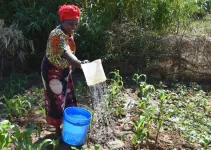(Press-News.org) DALLAS, Jan. 14, 2021 -- Adults who smoke or who are genetically predisposed to smoking behaviors are more likely to experience a serious type of stroke called subarachnoid hemorrhage (SAH), according to new research published today in Stroke, a journal of the American Stroke Association, a division of the American Heart Association. The results of this study provide important evidence that there is a causal link between smoking and the risk of SAH.
SAH is a type of stroke that occurs when a blood vessel on the surface of the brain ruptures and bleeds into the space between the brain and the skull. It mainly affects middle-aged adults and has high rates of complications and death.
"Previous studies have shown that smoking is associated with higher risks of SAH, yet it has been unclear if smoking or another confounding condition such as high blood pressure was a cause of the stroke," said senior author of the study Guido Falcone, M.D., Sc.D., M.P.H, an assistant professor of neurology at Yale School of Medicine in New Haven, Connecticut. "A definitive, causal relationship between smoking and the risk of SAH has not been previously established as it has been with other types of stroke."
To determine whether there is a causal effect of smoking and SAH, researchers analyzed the genetic data of 408,609 people from the UK Biobank, ages 40 to 69 at time of recruitment (2006-2010). Incidence of SAH was collected throughout the study, with a total of 904 SAHs occurring by the end of the study. Researchers developed a genetic risk scoring system that included genetic markers associated with risk of smoking and tracked smoking behavior data, which was collected at the time each participant was recruited.
Researchers found that:
the relationship between smoking and SAH risk appeared to be linear, with those who smoked half a pack to 20 packs of cigarettes a year having a 27% increased risk;
heavier smokers, those who smoked more than 40 packs of cigarettes a year, were nearly three times more at risk for SAH than those who did not smoke; and,
people who were genetically predisposed to smoking behaviors were at a 63% greater risk for SAH.
"Our results provide justification for future studies to focus on evaluating whether information on genetic variants leading to smoking can be used to better identify people at high risk of having one of these types of brain hemorrhages," said Julian N. Acosta, M.D., neurologist, postdoctoral research fellow at the Yale School of Medicine and lead study author. "These targeted populations might benefit from aggressive diagnostic interventions that could lead to early identification of the aneurysms that cause this serious type of bleeding stroke."
Researchers say while their findings suggest a more pronounced and harmful effect of smoking in women and adults with high blood pressure, they believe larger studies are needed to confirm these results. Their analysis is also limited by the type of data used in the UK Biobank, which, like all large information resources, rely on standardized treatment codes from medical charts, whereas smaller studies are focused on more detailed health records and information for each individual.
INFORMATION:
Co-authors are Natalia Szejko, M.D., Ph.D.; Cameron Both, B.S.; Kevin Vanent, B.S.; Rommell Noche, M.S.; Thomas Gill, M.D.; Charles Matouk, M.D.; Kevin Sheth, M.D.; and Murat Gunel M.D. Author disclosures are in the manuscript.
Funding sources and author disclosures are included in the manuscript.
Additional Resources:
Multimedia is available on the right column of the release link:
https://newsroom.heart.org/news/smoking-directly-linked-to-a-higher-risk-of-subarachnoid-hemorrhage?preview=404e0639e022f960c702452527506de0
After Jan. 14, 2021, view the manuscript online.
Smoking linked to bleeding in the brain in large, long-term study of twins
Men younger than 50: the more you smoke, the more you stroke
Risk of stroke may more than double for African Americans who smoke
Women's lifestyle changes, even in middle age, may reduce future stroke risk
Follow AHA/ASA news on Twitter @HeartNews
Follow news from Stroke, the ASA/AHA journal @StrokeAHA_ASA
Statements and conclusions of studies published in the American Heart Association's scientific journals are solely those of the study authors and do not necessarily reflect the Association's policy or position. The Association makes no representation or guarantee as to their accuracy or reliability. The Association receives funding primarily from individuals; foundations and corporations (including pharmaceutical, device manufacturers and other companies) also make donations and fund specific Association programs and events. The Association has strict policies to prevent these relationships from influencing the science content. Revenues from pharmaceutical and biotech companies, device manufacturers and health insurance providers are available here, and the Association's overall financial information is available here.
About the American Stroke Association
The American Stroke Association is a relentless force for a world with fewer strokes and longer, healthier lives. We team with millions of volunteers and donors to ensure equitable health and stroke care in all communities. We work to prevent, treat and beat stroke by funding innovative research, fighting for the public's health, and providing lifesaving resources. The Dallas-based association was created in 1998 as a division of the American Heart Association. To learn more or to get involved, call 1-888-4STROKE or visit stroke.org. Follow us on Facebook and Twitter.
MEDFORD/SOMERVILLE (January 14, 2021) - A team of researchers led by engineers at Tufts University's School of Engineering and Stanford University's Program on Water, Health and Development have developed a novel and inexpensive chlorine dispensing device that can improve the safety of drinking water in regions of the world that lack financial resources and adequate infrastructure. With no moving parts, no need for electricity, and little need for maintenance, the device releases measured quantities of chlorine into the water just before it exits the tap. It provides a quick and ...
There is a growing consensus among scientists as well as national and local governments representing hundreds of millions of people, that humanity faces a climate crisis that demands a crisis response. New research from the University of California San Diego explores one possible mode of response: a massively funded program to deploy direct air capture (DAC) systems that remove CO2 directly from the ambient air and sequester it safely underground.
The findings reveal such a program could reverse the rise in global temperature well before 2100, but only with immediate and sustained investments from governments and firms to scale up the new technology.
Despite the enormous undertaking explored in the study, the research ...
Honeybee historians might seem like a flight of fancy but these tiny pollinators have been helping researchers from the National Botanic Garden of Wales track how the UK's fields, hedgerows, wild spaces and gardens have changed since the 1950s.Using cutting-edge DNA barcoding techniques, scientists at the Botanic Garden identified which plants modern-day honeybees visited most often by looking at the pollen grains trapped within honey.
They compared this to a 1952 survey of honey plants where a microscope had been used to painstakingly identify pollen grains in honey sent from hives across the country. The differences were clear. White clover had been the most important plant for honeybees but, with fewer pastures today and increased use of herbicides and inorganic ...
New research has unlocked the mystery of how the Galápagos Islands, a rocky, volcanic outcrop, with only modest rainfall and vegetation, is able to sustain its unique wildlife habitats.
The Galápagos archipelago, rising from the eastern equatorial Pacific Ocean some 900 kilometres off the South American mainland, is an iconic and globally significant biological hotspot. The islands are renowned for their unique wealth of endemic species, which inspired Charles Darwin's theory of evolution and today underpins one of the largest UNESCO World Heritage Sites and Marine Reserves on Earth.
Scientists have known ...
Water isn't just crucial for life, it's fundamental to increasing opportunities for women and girls in rural areas across the globe. A new Stanford study reveals how bringing piped water closer to remote households in Zambia dramatically improves the lives of women and girls, while also improving economic opportunities, food security and well-being for entire households. The research, recently published in Social Science & Medicine, could spur governments and NGOs to more carefully evaluate the costs and benefits of piped water as an alternative to less accessible communal water sources.
"Switching from the village borehole to piped supply saved almost 200 hours of fetching time per year for a typical household," said study senior ...
A new paper in Q Open finds that the availability of fast food restaurants on the route between children's houses and their schools does not affect children's weight.
Reducing the rate of childhood obesity is a top public health priority in the United States where obesity rates are 18.4% for those ages 6-11 and 20.6% for those ages 12-19. Childhood obesity is a documented risk-factor for negative physical and mental health outcomes. Obese children are also more likely to become obese adults and suffer associated health problems.
Researchers have proposed that the accessibility ...
Researchers in South Korea have developed a phototherapy technology that can significantly increase efficiency while reducing the pain of chemotherapy and minimizing side effects after treatment. The President of Korea Institute of Science and Technology (KIST), Seok-Jin Yoon announced that a research team led by Dr. Se-hoon Kim at the Theragnosis Research Center (KU-KIST Graduate School of Converging Science and Technology) has developed a cancer-targeted phototherapeutic agent that promises complete elimination of cancer cells without side effects. It involves only one injection and repeated phototherapy. This development ...
While there is an abundant amount of research about traumatic brain injuries in athletes and those serving in the military, the same data is scarce when it comes to concussions and head and neck injuries sustained due to intimate partner violence.
Carrie Esopenko, assistant professor in the Department of Rehabilitation and Movement Sciences in the Rutgers School of Health Professions says that the World Health Organization estimates that one in three women will experience intimate partner violence (IPV) in her lifetime, and studies suggest that anywhere between 30% to 90% of women who experience physical abuse at the hands of an intimate partner experience head trauma. Yet not enough data is being collected to understand how this head trauma affects cognitive and psychological ...
Cities have become the focus of global climate mitigation efforts because as they are responsible for 60-70% of energy-related CO2 emissions. As the world is increasingly urbanized, it is crucial to identify cost-effective pathways to decarbonize and enhance the resilience of cities, which ensure the well-being of their dwellers. In this study, we propose a "SolarEV City" concept, in which integrated systems of cities' roof-top photovoltaics and electric vehicles (EVs) supply affordable and dispatchable CO2-free electricity to urban dwellers.
The SolarEV City assumes that 70% of toof-top of cities at maximum are used for PV and all passenger vehciles are converted to ...
August 2020 set new record high sea surface temperatures (SSTs) in the northwestern Pacific Ocean and around the Japan coasts. A new study led by National Institute for Environmental Studies (NIES) researchers revealed that this warming record could not happen without human-induced climate changes.
The northwestern Pacific sea surface becomes warm seasonally around August every year. However, it was unprecedentedly high in August 2020, according to the Japan Meteorological Agency and the National Oceanic and Atmospheric Administration. The extremely high SSTs exceeding 30°C, which lasted until mid-September, may have intensified tropical cyclones such as ...






